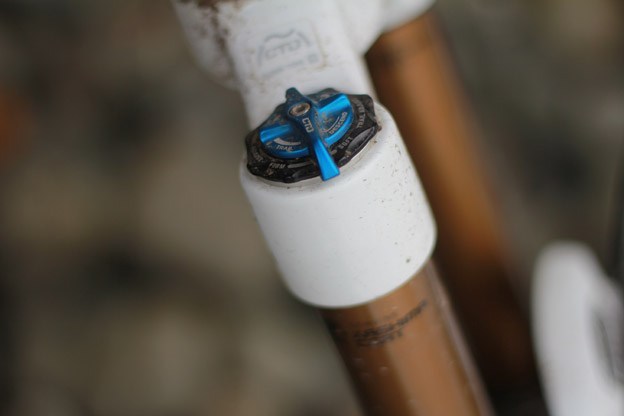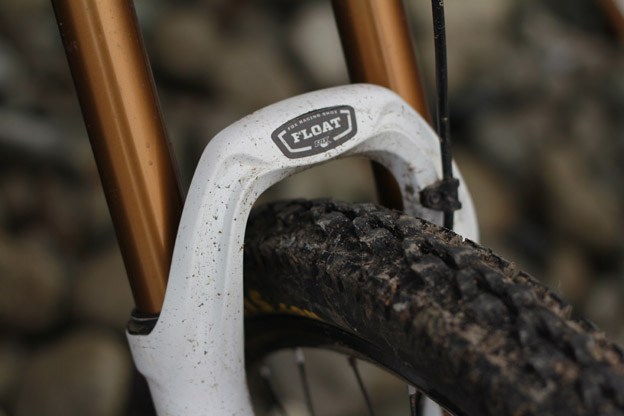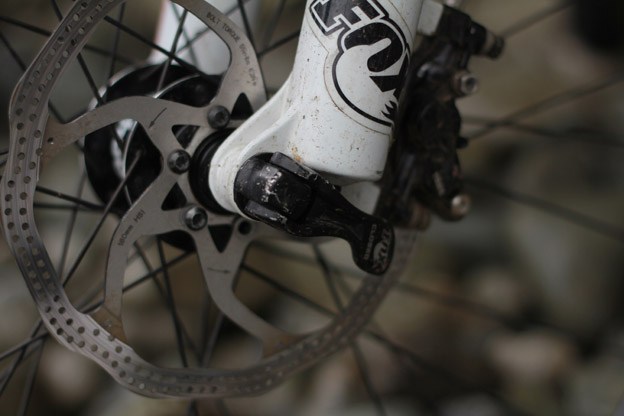
Review: Fox 34 Float 160 CTD 26″
Words by Seb Kemp. Photos by Seb Kemp, Sven Martin, and Irmo Keizer.
Hot on the heels of the 2012 29er FOX 34 we tested this summer, we received the 26” version of this chassis. There are some distinct differences between the 29” and 26” version we tested, and not just the length of them. For 2013 FOX introduced the CTD system and gave the fork a more linear spring curve.
The 34 forks offer a claimed 20 percent stiffness boost over an equivalent FOX 32 fork but shed almost half a pound from a comparable FOX 36 fork (the numbers compare a 34 Float 160 FIT CTD w/ Trail Adj to a 32 Float 150 FIT CTD w/ Trail Adj 150 and a 36 Float 160 FIT RC2). To drop the weight but increase the torsional stiffness FOX engineers didn’t just split the difference in chassis diameter between the race and trail oriented 32 and the burly, heavy hitting 36. They redesigned the brace, dropouts and wall thickness too.

CTD doesn’t have quite as many clicks as its predecessors, but provides a decent range of damping adjustment with slightly different characteristics.
I took the 34 with me to France when I raced the Trans-Provence in September. I guessed that for a week of sustained effort balancing stout performance and weight would be crucial.
Many of the trails we rode that week featured long, heavily eroded straightaways which required a degree of finesse to skip to the smoothest lines and a dose of heavy handed brute force to plow through the zero-option rougher options. Just as you get into the groove there was often a very abrupt turn, followed by another perpendicular corner. In these conditions the bike goes from dealing with straight on hits and lateral line finding to very heavy braking, concentrated edge finding, and flip flopping between turns. With the 34 I found myself able to brake with confidence and able to manipulate the bike in a candid fashion. The points of pressure control I exacted upon the bike were clearly translated to the contact surfaces of the tires.
There were a couple of times that I will confess to wishing for even more fork (and bike) as we raced all of these trails utterly blind, meaning that it was a challenge to strike a balance between given’r and riding with care. However, each time we faced a 10km, 600m climb or hike-a-bike I was relieved to have the 34’s lack of heft.
The 2013 models have FOX’s new easy to understand CTD compression one-stop-shop which offer three settings, one for Climbing, one for Trailing and one for Descending. CTD is designed to be an easier system for riders that don’t fully understand damping. The CTD system offers lots of damping adjustments (five in total) but is simpler for riders to understand and use.

The Fox 34 Float 160 is significantly stiffer than a 32 150, and lighter than a 36 160 – but how does it handle on the trail?
The Lockout feature that was present on previous models directly compares to the Climb mode. With CTD riders get a great handling, supportive Trail mode as well as a supple Descend mode with the flick of the lever. I really like the option of the good handling Trail mode and the open Descend mode. I used Trail mode most of the time because it blows open much better than RLC ever did. It is far more intuitive now, and when combined with FOX’s CTD rear shocks it provides a very useable range of settings that are easy to adjust while on the fly.
More so, the 2013 models have a redesigned spring curve with a more linear spring rate. FOX found that some people were not achieving full travel on their forks. I found myself using all the travel on the 34 with no problem, and on some days increased the air volume in the fork to avoid bottoming out on the most ferocious of stages. The 34 still maintains that buttery supple (a mention should go out to Kashima for assisting this) yet highly controlled damping that makes their single-crown forks winners, but now all of that travel is available to more riders.
You can get into a Fox 34 Float 160 CTD for about $1250.00 CDN.
For those of us who believe the Fox 32 is not quite enough for AM riding, while the 36 is overkill, the 34 presents a good middle ground. Have you had any time on the 34?











Comments
berggams
11 years, 4 months ago
You can also say, the 36 is Stiffer than the 34. And the 34 weights much more then the 32!!!!!!!!!!!!!
Reply
slyfink
11 years, 4 months ago
no sir… I said it was the most common complaint, not that is was so. I was just wondering what your take on that complaint was. Thanks for the thorough response.
For me, I think I have to stick to 36s anyways, at my weight and riding style I feel like smaller forks are wet noodles. Or maybe it's just that I've been riding a 36 for 7 years and that I'm used to the stiffness and anything smaller feels like a wet noodle. Either way, this looks like a nifty fork, just not for me.
Reply
RV
11 years, 4 months ago
I went from a Float 36, to a Float 36 RLC Kash, to a Marz 55. Seems to work A LOT better for me, my style/size/location etc…..
Reply
sebkemp
11 years, 4 months ago
@slyfink Here we go… Slyfink has said that it dives too much and doesn’t stay up in its travel but in my experience, it hasn’t been an issue.
Jokes aside, I really haven't found that to be a problem. Check out the picture above of the "buttery smooth farm track". That photo was just metres before the finish line of stage three on day three (I believe), and as you can see I am under full braking (from about 40mph). There's not too much dive there and you can see I am pretty centered over the bikes still. This is one situation when brake dive can be an issue, but wasn't for me. I didn't find it a problem when braking heavy into dead-stop hairpins either. It is on these turns that weight is most certainly pushed over the front to help initiate the Euro-Hairpin-Hop, or nose pivot. Honestly, I haven't found it to be a problem but perhaps I prefer setting my forks stiffer to start with.
Doddy from MBUK today informed me that he prefers the 34 with 25cc's added to the air chamber of the 34 as this makes it a little more progressive. I'm no scientist but this could be a fix if you find the fork too linear.
@Leith It's excellent to hear that you are a experienced rider however, don't discredit the fork because it isn't complex enough for you. You can still take it apart and do the real tuning to it if that makes you feel better. Don't worry, the other nerds won't think any less of you just because you have the CTD fork.
Personally, I feel CTD is excellent and not just for "beginners". It is easy and far easier to use on the trail and on the move. To get over the "wallowy" feel that Syngltrkmnd and Morgman refer to, I set more air into the fork (not a cigarette paper over 20% sag) and run "T" in the softest setting. This keeps "D" all taut, like I want when things get rowdy, but keeps the fork compliant when I'm rolling trail. However, the beauty of the CTD is that if I visit new trails and I feel the "T" setting is too soft then I can firm it up on-the-fly without altering the "D".
To @ibeaver, yes Fabien was running 36s, but have you seen him ride or the set up he personally rides with? He is not human and his set up is designed to work for him. I don't think this fork should replace the 36, but that perhaps some people (meaning the trails they ride on and the way they ride) would benefit from the 34 over a 36. This is an additional choice.
Why are manufacturers speccing 34s on big boy bruiser bikes like the Enduro or Slash? Perhaps they found that most people that buy these bikes really don't need a 36 up front after all. Or perhaps they are making a monumental mistake by speccing the wrong fork. Perhaps the very few people that actually buy these bikes won't notice or perhaps the hardcore semi-freeride, ride-all-day segment of the market just doesn't exist (or translate to sales) and manufacturers are trying to get more people onto these types of bikes. I don't know, which is all I know.
I personally think having the sturdiest fork up front is important (tracking, handling, stability, control are of highest importance for the riding I like and where I ride) and I would rather see bikes come over specced on the front bouncers than unbalanced with not enough up front and more on the rear. There is a few manufacturers who keep underspeccing the forks on their bikes, leaving otherwise excellent bikes neutered and castrated. This is a shame. However, I do think that unless you are a Shire horse or very accomplished rider you might be jumping the gun to discredit the Fox 34 for daily driver duties. Not think of it as a tame and lame 36, but rather a busty and muscly 32.
Have fun,
Seb
Reply
Morgan Taylor
11 years, 4 months ago
Great reply, thanks Seb. I had a feeling that would be your response, and I will set up the next CTD fork I jump on with that in mind. I've found the characteristics of the CTD damper are quite nice in T-firm with a bit less air, and am looking forward to trying one out on a longer-term basis.
You are absolutely right about it not being a tame and lame 36, but a burlier option for those who find the 32 chassis at long travel a bit undergunned. I recently dropped my 32 from 140 to 100 and it feels much more at home there.
Reply
ibeaver
11 years, 4 months ago
Hey Seb, ya you are right… its true a lot of the guys that I come across on the trails with bikes like mine, wont' be keeping up with me 36 or 34, so the 34 fits their bill better than a 36 (newer, lighter, cooler)
And in that case, you are correct again, I can't in any way keep up with Fab…. but trying is fun 🙂
I suppose I was dreaming of a new ride this year but I don't want to have to also pay up to swap out a fork and a shock etc…
(I rode the 34 last year and when I was back on my 36 - I was smiling normal. )
happy trails!
Reply
richtpop
10 years, 9 months ago
brilliant.
i currently ride a pivot mach 5.7 c with 32 float ctd 150mm and do notice flex from time to time, you have just made my mind up , 34 float 150 ctd it is.
i ride alot and agree with everything you have said about the ctd system. it just works for me and over the years i have spent a lot time messing with suspension setups on mtb and mx bikes and when you get something that works it is my experience to not mess with it any more.
cheers seb for a great review.
Reply
syngltrkmnd
11 years, 4 months ago
This is definitely in the running for my next fork. I am starting a third season on a Float 32 150 on a 6″ travel DB Mission, and a stouter fork would be welcome.
I am surprised there was no criticism of the "D" mode - I have had a little time on the CTD forks and shocks, and found "D" very wallowy when the air chamber is set up correctly for me in "C" and "T". Different strokes…
Reply
Morgan Taylor
11 years, 4 months ago
Different strokes indeed! (Puntastic.) I've personally found the T mode to give me all I want in terms of damping, and find the D mode to be too wide open for spirited descending. Maybe we need to try more air?
Reply
ibeaver
11 years, 4 months ago
but the question to be answered is why FOX pushing that all the bikes I expect to run with the 36 are getting the 34? PEF's commencal, trek slash, spec enduro pro, etc… 200grams is that really worth the trade off's? I say no.
you rode with Fab for the week… I'm pretty sure he was riding the 36. ON a 140mm Mondraker. 🙂
Hope you had a good time on the trans-provence… I hope to do it next year 🙂
Reply
Leith
11 years, 4 months ago
It seems like CTD should be a feature offered on entry level forks, as most experienced riders know how to use a real compression adjustment. For that reason I won't even consider this fork.
Reply
slyfink
11 years, 4 months ago
No mention of the most common complaint of this fork? that it dives too much and doesn't keep you up in your travel? I can understand that this many not be a problem for you, but you could at least have addressed it in your review. A la "some have said x,y,z, but in my experience, it hasn't been an issue"… is that the case? Hasn't been an issue for you?
Reply
Please log in to leave a comment.